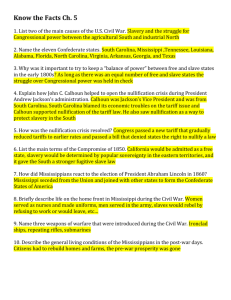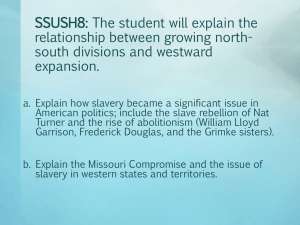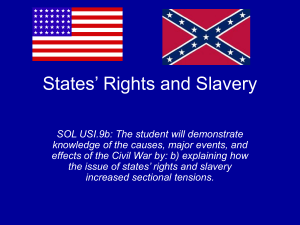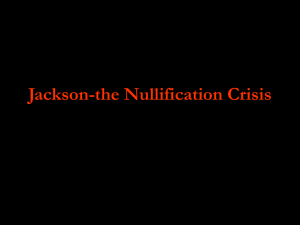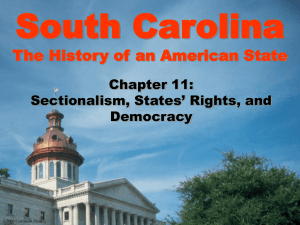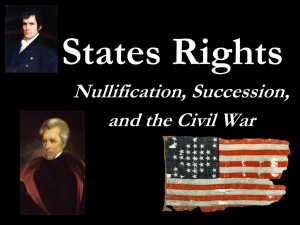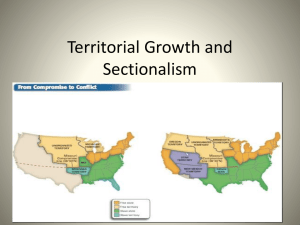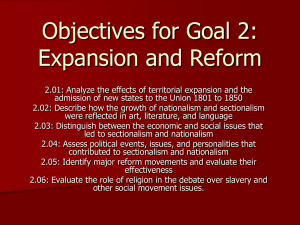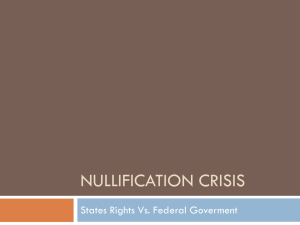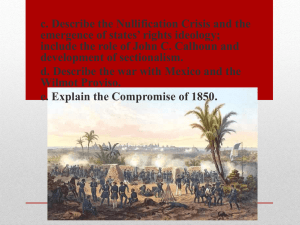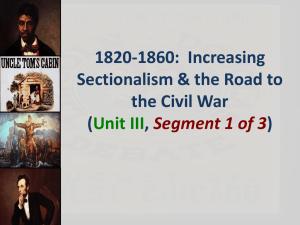Slide 1
advertisement
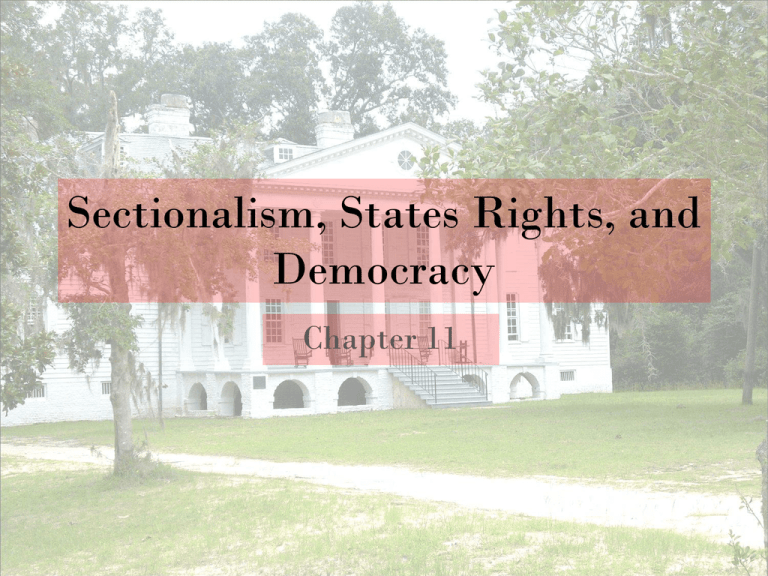
Sectionalism, States Rights, and Democracy Chapter 11 Sectionalism The period of nationalism lasted in the United States for only a short while. Sectionalism started to develop between the North and South because of differences in economy, culture, and political interests. Opposite of nationalism, sectionalism is loyalty to a particular region or section of a country instead of to the nation as a whole. Sectionalism Differences between the two regions first developed in the colonial period as a result of the different geographies of the regions. The North’s economy developed as a trading region of small farms and industries, while the South’s economy developed the plantation system The two regions also had different political beliefs. Southerners tended to be Democratic-Republican followers of Thomas Jefferson who called themselves Republicans. New Englanders tended to be Federalists (and later Whigs). The political parties and the regions took different positions on the issues of the day. Sectionalism When America was first being colonized, both regions had slavery. After the American Revolution, the Northern states slowly emancipated (set free) their slaves because there was little need for slave labor in the industrial North. In the South, the invention of the cotton gin led the South to become even more economically dependent upon slave labor. Sectionalism Industry attracted European immigrants to jobs and allowed the North to have a larger representation in the House of Representatives. The South did not attract immigrants in large numbers. Instead, the population of the South was growing because of the natural increase of the slave population. Although the international slave trade was outlawed in 1808, the numbers of slaves grew due to higher birth rates and smuggling. Sectionalism The growing abolition movement caused even more tension. Southerners believed that planting was the only respectable job, and they began to fear that the abolitionist opinions would force them to give up slavery. The South tried to keep anti-slavery propaganda out of their region, but they could not keep abolitionists from reaching a larger and larger Northern audience and convincing them of the evils of the ‘peculiar institution.’ Southerners responded in anger to abolitionists’ criticism, claiming that slavery was actually good, because it cared for workers throughout their lives. Denmark Vesey Plot In South Carolina, by the 1720’s, the black population surpassed the white population and there was an African American majority in most Southern states, and sectionalism increased as a result of the growing slave population. The Denmark Vesey plot caused Southerners to become even more fearful and controlling of their slaves. Vesey was a free black carpenter in Charleston who supposedly organized a revolt of 9,000 followers to help free his race from slavery. The revolt was discovered before it took place and Vesey was hanged. Denmark Vesey Plot Slave codes that had been developed as a result of the Stono rebellion during colonial times were strengthened to better protect white society. The General Assembly passed laws that prohibited slaves from meeting, learning to read and write and that regulated all aspects of slaves’ lives. The Missouri Compromise As the United States continued to grow, the North and South disagreed on allowing slavery in new territories. Southerners feared that if slavery could not expand into the territories eventually the national government would be in the hands of the North, slavery would be outlawed, and Southerners would have a large African American population that they could not control. Both sides became more stubborn in their beliefs and were less and less willing to compromise on the issue of expansion of slavery into the territories. This tension was very visible in the controversy surrounding the statehood of Missouri. The Missouri Compromise Northern states were concerned about Missouri joining the Union as a slave state because it was the first state admitted from the Louisiana Purchase and it would upset the equal balance of slave and free states’ votes that was balanced in the Senate. The Missouri Compromise was reached that admitted Missouri as a slave state and Maine as a free state. It also tried to avoid future controversy by prohibiting slavery in the Louisiana Territory north of the 36 30’ latitude line. The South learned from this crisis the importance of maintaining the balance of Senate votes from slave and free states. The Nullification Crisis Political cartoon of the results of the protective tariffs. In the 1828, South Carolinians opposed a high protective tariff that was designed to raise import taxes on goods coming from foreign countries in order to make them more expensive than goods produced in the United States. This would benefit the emerging industries in the North. However, since South Carolina was largely agricultural, a protective tariff would raise the price of the manufactured goods that South Carolinians would buy from the industrial north or from Great Britain. Therefore southerners objected to raising the protective tariff. The Nullification Crisis For example, South Carolina could buy a chair from France for $5, while the chairs from the North were $8. The protective tariff placed a tax on the chairs from Great Britain raising the cost to $9. South Carolina could still by the chairs from Great Britain, but they would have to pay more; they could also buy chairs from the North, but it was still more expensive than if they only had to pay $5. (Note: these numbers are not real prices.) The Nullification Crisis Andrew Jackson John Calhoun When the United States Congress passed a protective tax in 1828, then Vice President John C. Calhoun, of South Carolina, anonymously wrote a booklet claiming that it was a states’ right to declare such a law unconstitutional and nullify it through a special state convention. If stated could do this, then they could declare anything they didn’t like unconstitutional, and would weaken the federal government. Both Washington, D.C. and South Carolina debated this opinion. The Nullification Crisis South Carolinians split into a States’ Rights Party, or Nullifiers, and a Union party Unionists. Nullifiers believed that states should have the right to nullify laws made by the federal government, Unionists did not. In 1832, the Nullifiers won control of the General Assembly. When the United States Congress passed another tariff in 1832, the South Carolina legislature called a meeting to nullify the tariff. John C. Calhoun resigned the vice presidency and entered the U. S. Senate where he was a strong voice against the tariff and for nullification. Nullifiers Unionists The Nullification Crisis The South’s reaction to Jackson’s Force Bill. President Andrew Jackson condemned the nullifiers and said it was treason for a state to ignore federal laws. He urged Congress to pass a Force Bill that would authorize the national government to send troops to collect the tariff in South Carolina. The crisis ended with a compromise. Congress lowered the tariff and the South Carolina repealed (took back) the nullification. However, South Carolina then nullified the Force Bill, thus asserting a state’s right to declare an act of Congress to be unconstitutional in that state. The states’ right idea would continue to develop.
